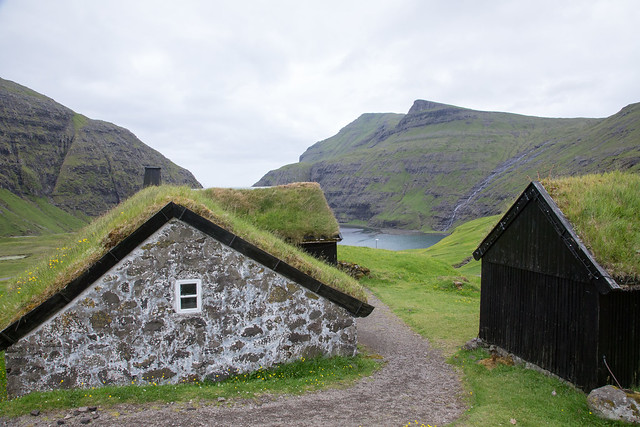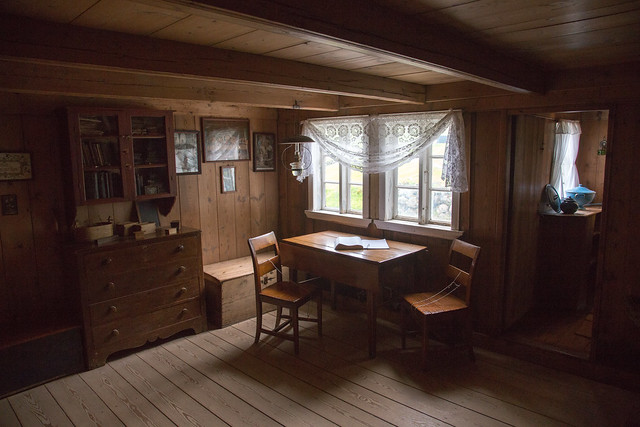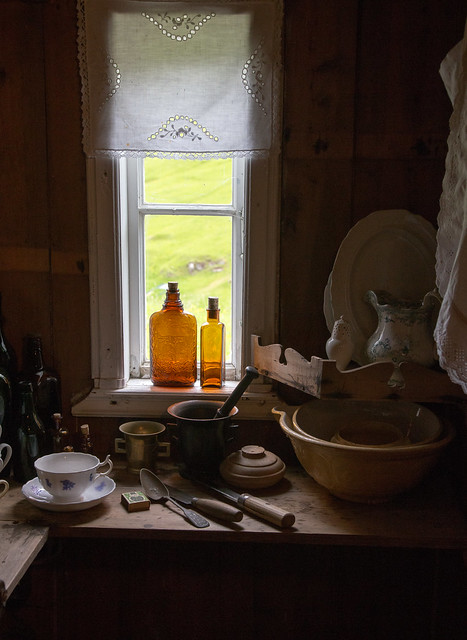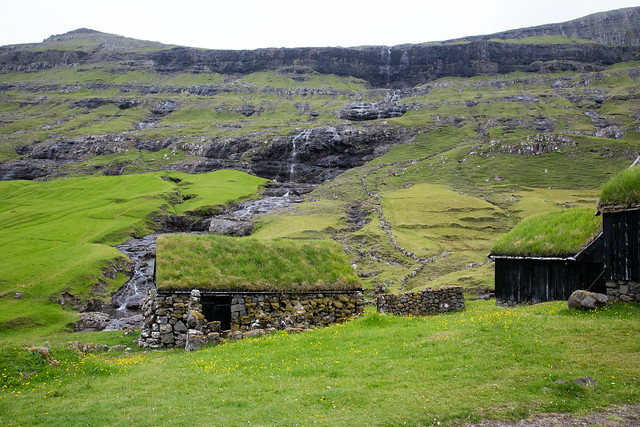Visiting the Faroe Islands
#16
Original Poster
Join Date: Mar 2008
Location: Grantham, NH
Posts: 530
Next to Ëlavskirkjan is Kirkjub°m˙rurin, also known as "Magnus' Cathedral". Construction started by Bishop Erlendur about the year 1269, when he thought the Islands needed a majestic cathedral. He was forced by the Danes to leave the islands in 1303, and work slowed down substantially, but continued piecemeal until around 1500, when they basically gave up and focused on rebuilding Ëlavskirkjan again.
It's currently having conservation work done, however.
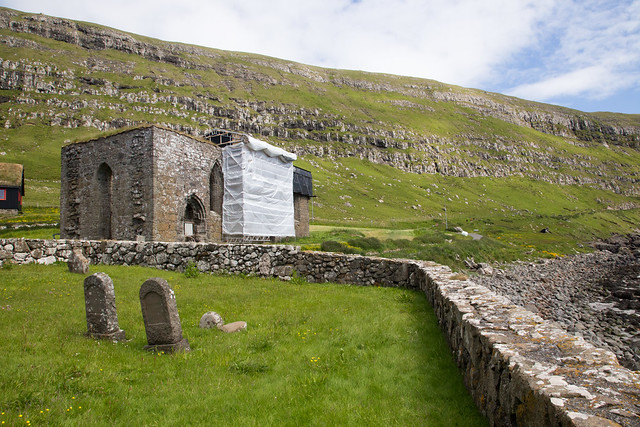
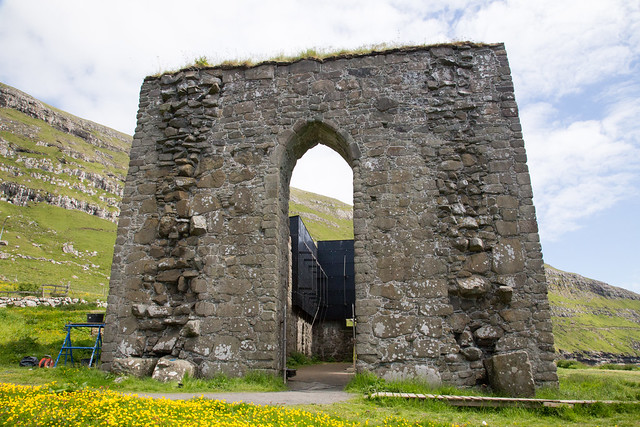

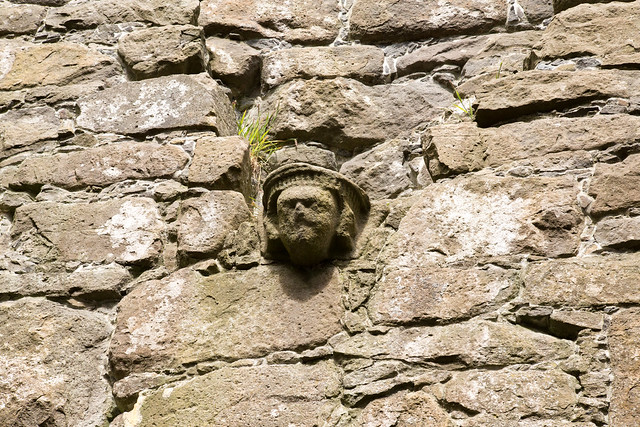
There are even remnants of an old spiral stone staircase:

It's currently having conservation work done, however.




There are even remnants of an old spiral stone staircase:

#17
Original Poster
Join Date: Mar 2008
Location: Grantham, NH
Posts: 530
One of the main reasons we went to the Faroe Islands was hiking, and since the weather was, by Faroese standards, excellent (that translates to 50 degrees and sunny), we went on a hike to TrŠlanÝpa and Leitisvatn.
Letisvatn is the largest freshwater lake in the Faroes, and it's a hanging lake, draining by waterfall into the Atlantic, and there's a large sea cliff, TrŠlanÝpa, nearby that provides a good vantage point. But it's a bit of a hike to get here. Here, you can see the TrŠlanÝpa off in the distance:

About halfway to TrŠlanÝpa you come to a notch in the ridge, and you get a good view in each direction:
Here's looking at Leitisvatn:

Here's looking at TrŠlanÝpa, which is around 500' (small by Faroese standards)

Here's the view out of the notch. Looking across there's Koltur, Streymoy (behind Koltur), Hestur, Sandoy, Skuvoy (along the right edge of Sandoy), and Suduroy:
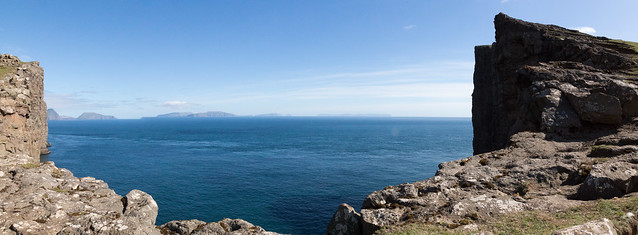
Getting to the top of TrŠlanÝpa, the view of Leitisvatn is pretty good. There's a bit of a weird optical illusion at Leitisvatn since the lake and sea are at different levels, but it doesn't convey in 2D images:

Letisvatn is the largest freshwater lake in the Faroes, and it's a hanging lake, draining by waterfall into the Atlantic, and there's a large sea cliff, TrŠlanÝpa, nearby that provides a good vantage point. But it's a bit of a hike to get here. Here, you can see the TrŠlanÝpa off in the distance:

About halfway to TrŠlanÝpa you come to a notch in the ridge, and you get a good view in each direction:
Here's looking at Leitisvatn:

Here's looking at TrŠlanÝpa, which is around 500' (small by Faroese standards)

Here's the view out of the notch. Looking across there's Koltur, Streymoy (behind Koltur), Hestur, Sandoy, Skuvoy (along the right edge of Sandoy), and Suduroy:

Getting to the top of TrŠlanÝpa, the view of Leitisvatn is pretty good. There's a bit of a weird optical illusion at Leitisvatn since the lake and sea are at different levels, but it doesn't convey in 2D images:

#18
Original Poster
Join Date: Mar 2008
Location: Grantham, NH
Posts: 530
Looking east frmo the top of TrŠlanÝpa, the view got even better:

There are a bunch of old foundations up there, let over from WWII when the British maintained an observation and early warning station for the nearby Vagar airport. During days like my hike that must have been a great posting. During the winter? Not so much (the Faroes are famously windy and misty in the winter):
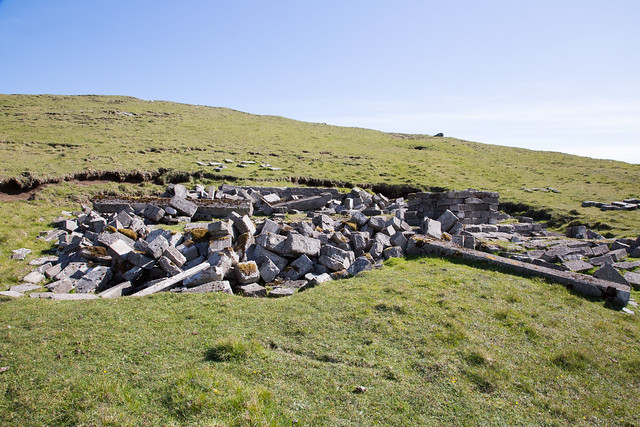
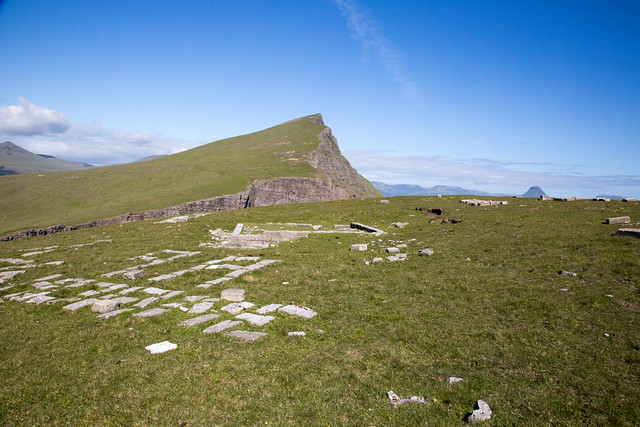
Here's Carol enjoying the view (staying far away from the sheer cliff):

And we weren't the only people enjoying the weather. We got a nice wave in to the Atlantic Airways sightseeing helicopter that passed by:
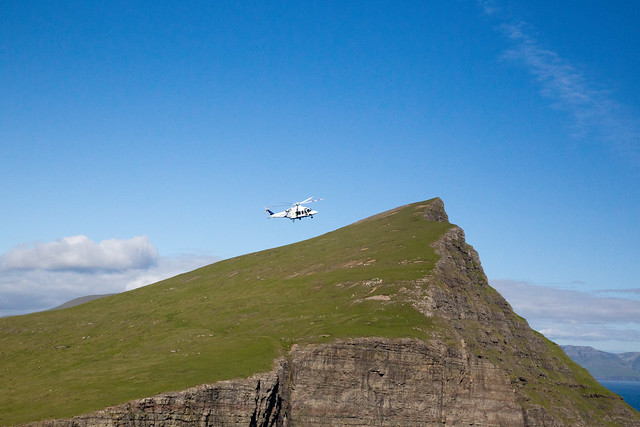

There are a bunch of old foundations up there, let over from WWII when the British maintained an observation and early warning station for the nearby Vagar airport. During days like my hike that must have been a great posting. During the winter? Not so much (the Faroes are famously windy and misty in the winter):


Here's Carol enjoying the view (staying far away from the sheer cliff):

And we weren't the only people enjoying the weather. We got a nice wave in to the Atlantic Airways sightseeing helicopter that passed by:

#19
Original Poster
Join Date: Mar 2008
Location: Grantham, NH
Posts: 530
After that hike, we were a bit hungry. While the food scene in the Faroes is limited, there are some niches where the offerings are quite good. One of them is Etika, Torshavn's best (only) sushi shop:

A few things to note about sushi in the Faroes:
1. There's no tuna. The tuna stocks in the North Atlantic are low, and it's too pricey to import.
2. There's salmon. A lot of salmon. While it has the softer taste of farmed salmon (because, well, it's all farmed), it's quite good.
3. There was a new one to me: Porbeagle. It's a type of shark. It's not bad.
On the left are salmon and porbeagle. The specialty roll on the right was tempura shrimp with mango, spicy mayo, and salmon

We also had some good tempura shrimp (shrimp and langoustine are pretty common catch from the trawlers) and a surprisingly good salmon salad:


I also got to try Black Sheep, one of the flagship beers of the older F÷roya Bjˇr brewery:
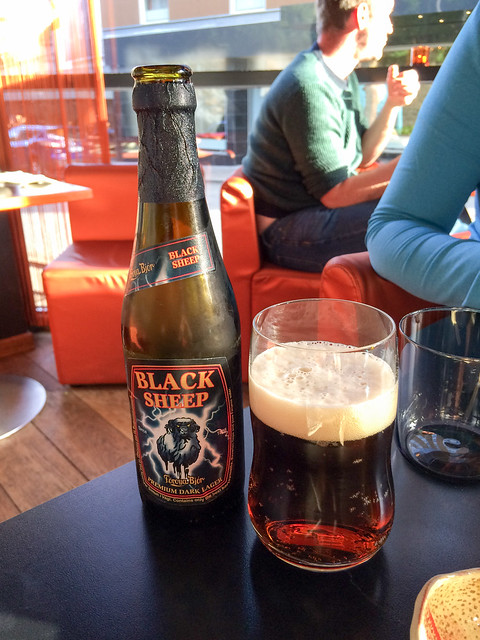

A few things to note about sushi in the Faroes:
1. There's no tuna. The tuna stocks in the North Atlantic are low, and it's too pricey to import.
2. There's salmon. A lot of salmon. While it has the softer taste of farmed salmon (because, well, it's all farmed), it's quite good.
3. There was a new one to me: Porbeagle. It's a type of shark. It's not bad.
On the left are salmon and porbeagle. The specialty roll on the right was tempura shrimp with mango, spicy mayo, and salmon

We also had some good tempura shrimp (shrimp and langoustine are pretty common catch from the trawlers) and a surprisingly good salmon salad:


I also got to try Black Sheep, one of the flagship beers of the older F÷roya Bjˇr brewery:

#20
Original Poster
Join Date: Mar 2008
Location: Grantham, NH
Posts: 530
While there's not exactly a wealth of travel info in English for the Faroes (the Lonely Planet "Guide" for the Faroes is, literally, a single page in the back of the Iceland guide, for example), most any guide has a few "must see" lists for the Faroes.
One of these is seeing the Vestmanna Cliffs (they are also one of the few things on the Island that require a lot of advance planning, since tickets are pretty limited)
Vestmanna used to be a bustling ferry port, being the only way between Streymoy and Vagar. Until 2002 when the tunnel caused the town to get abruptly bypassed.
It's still somewhat busy due to tourism, and being the location of three hydroelectric and two wind farm power stations.
The reason most people to go to Vestmanna is to take a boat ride over to the high Vestmanna Cliffs on the west end of Streymoy: a series of impressive tall canyons, grottos, and cliffs inhabited by a large number of birds.

It's still a nice little town, however, although it's definitely a bit rough about the edges if you wander from the tourist area (although the Faroes are quite possibly the lowest crime place you could visit)

Unless one asks a lot of questions, when you book tickets for a Vestmanna Cliffs tour, you pretty much get assigned randomly to a ship from the several that do tours.
We got tickets on the Silja Star, which was quite nice (and enclosed):

Or you could have ended up on the Frigerd, an open-top fishing boating also used for tours, captained by a self-described "Crazy Viking":

While definitely a wilder and wetter ride, if I had to do this again I might try to ride with the crazy viking, since they did seem to get into smaller spaces than our boat did.
One of these is seeing the Vestmanna Cliffs (they are also one of the few things on the Island that require a lot of advance planning, since tickets are pretty limited)
Vestmanna used to be a bustling ferry port, being the only way between Streymoy and Vagar. Until 2002 when the tunnel caused the town to get abruptly bypassed.
It's still somewhat busy due to tourism, and being the location of three hydroelectric and two wind farm power stations.
The reason most people to go to Vestmanna is to take a boat ride over to the high Vestmanna Cliffs on the west end of Streymoy: a series of impressive tall canyons, grottos, and cliffs inhabited by a large number of birds.

It's still a nice little town, however, although it's definitely a bit rough about the edges if you wander from the tourist area (although the Faroes are quite possibly the lowest crime place you could visit)

Unless one asks a lot of questions, when you book tickets for a Vestmanna Cliffs tour, you pretty much get assigned randomly to a ship from the several that do tours.
We got tickets on the Silja Star, which was quite nice (and enclosed):

Or you could have ended up on the Frigerd, an open-top fishing boating also used for tours, captained by a self-described "Crazy Viking":

While definitely a wilder and wetter ride, if I had to do this again I might try to ride with the crazy viking, since they did seem to get into smaller spaces than our boat did.
#21
Original Poster
Join Date: Mar 2008
Location: Grantham, NH
Posts: 530
The first part of the ride out from Vestmanna is a reminder that virtually every inch of the Faroes is actually someone's ancestral sheep pasture. Here's what is considered highly valued pasture land in the Faroes:
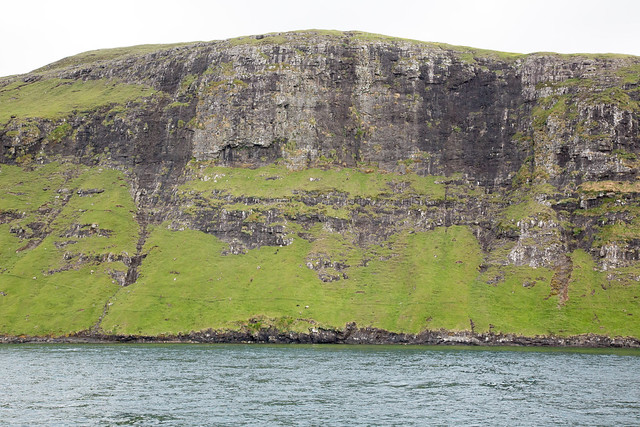
Yes, if you look closely, there are indeed sheep:
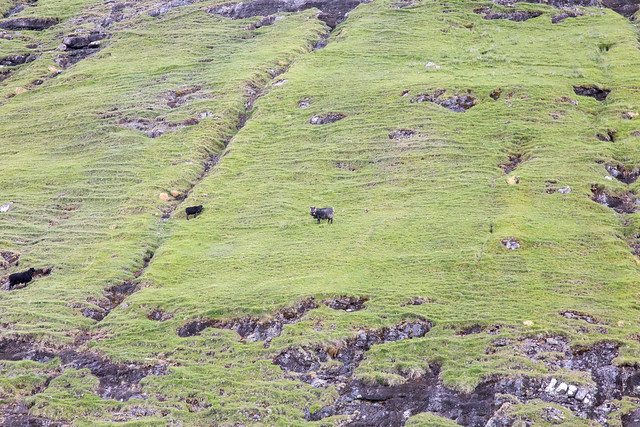
Going back to the days of the Sheep Letter, these lands are prized, since supposedly the exercise gives the meat a better flavor, and the natural barriers make it easier to keep the sheep from running off.
There's just one little problem: getting the sheep to and from the fields.
Supposedly they actually raise and lower them by boat from either the cliffs above, or boats below.
I really want to see them do that sometime.
There is also the occassional shelter for the sheepherders:
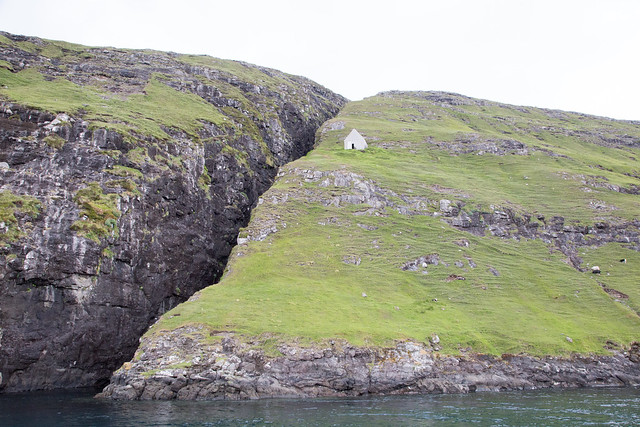
But mostly, they just graze away and enjoy themselves. Since despite the slope (which does occasionally result in a sheep tumbling to their death), it's also a 100% predator-free environment:
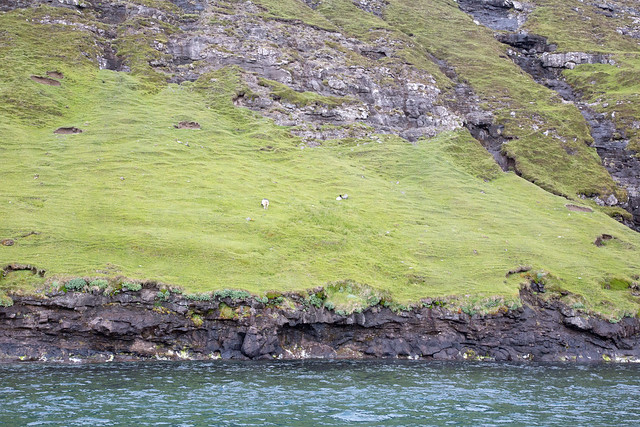

Yes, if you look closely, there are indeed sheep:

Going back to the days of the Sheep Letter, these lands are prized, since supposedly the exercise gives the meat a better flavor, and the natural barriers make it easier to keep the sheep from running off.
There's just one little problem: getting the sheep to and from the fields.
Supposedly they actually raise and lower them by boat from either the cliffs above, or boats below.
I really want to see them do that sometime.
There is also the occassional shelter for the sheepherders:

But mostly, they just graze away and enjoy themselves. Since despite the slope (which does occasionally result in a sheep tumbling to their death), it's also a 100% predator-free environment:

#22
Original Poster
Join Date: Mar 2008
Location: Grantham, NH
Posts: 530
The sharp cliffsides of Vestmanna mean a lot of birds nest in the cliffs (although recently bird populations here have dropped for unknown reasons).
A byproduct of that is a thick chalky layer of droppings along the cliffs:
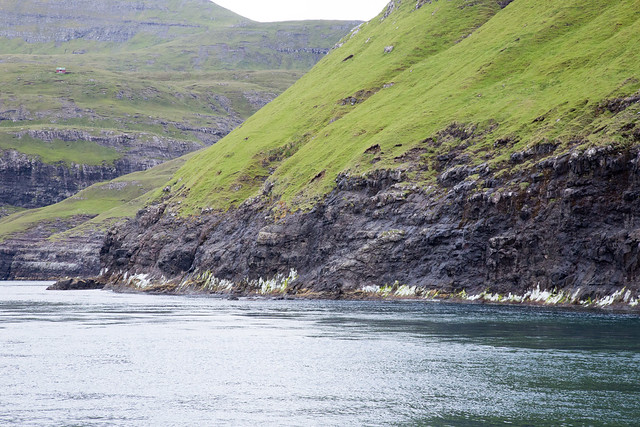
Most of the rock of the Faroes is a very hard basalt which resists the wave action well (leaving behind the famous steep cliffs), but every once in a while a fault rift or vein of softer rock occurs that the waves can erode, leaving a series of caves, grottos, tall canyons, and "sea stacks" (freestanding basalt formations).
Here's a relatively small (~12') cave:

And here's a small sea stack in front of a grotto (and yes, the ocean was that weird shade of blue-green):

We took a swing through that grotto in the boat, but it didn't really photograph well. But here you can see the crazy Viking going through behind us:
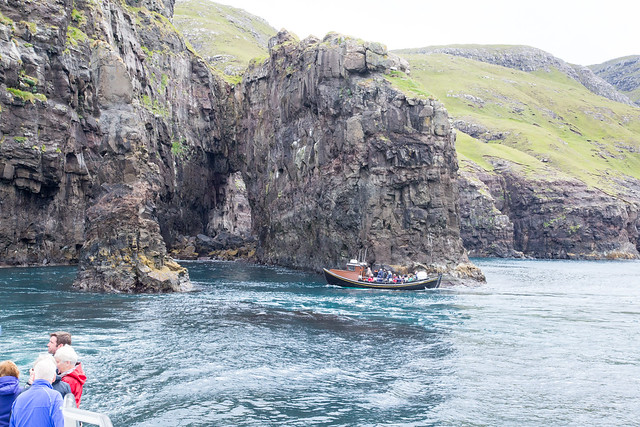
Pretty much the whole west end of the Islands is craggy like that:
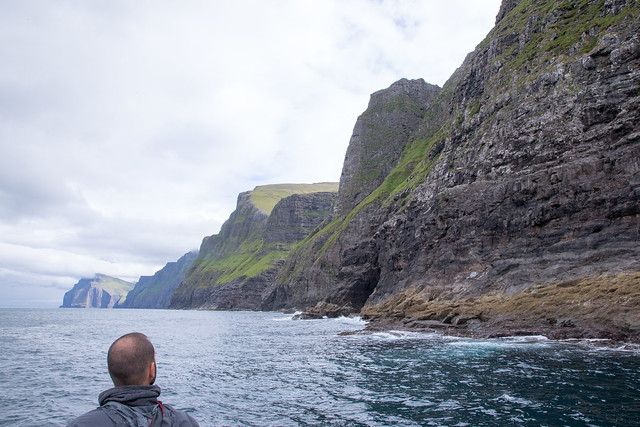
A byproduct of that is a thick chalky layer of droppings along the cliffs:

Most of the rock of the Faroes is a very hard basalt which resists the wave action well (leaving behind the famous steep cliffs), but every once in a while a fault rift or vein of softer rock occurs that the waves can erode, leaving a series of caves, grottos, tall canyons, and "sea stacks" (freestanding basalt formations).
Here's a relatively small (~12') cave:

And here's a small sea stack in front of a grotto (and yes, the ocean was that weird shade of blue-green):

We took a swing through that grotto in the boat, but it didn't really photograph well. But here you can see the crazy Viking going through behind us:

Pretty much the whole west end of the Islands is craggy like that:

#23
Original Poster
Join Date: Mar 2008
Location: Grantham, NH
Posts: 530
Here's one that did photograph pretty well. This formation is called "The Elephant"[1]. Squint a bit to see it:
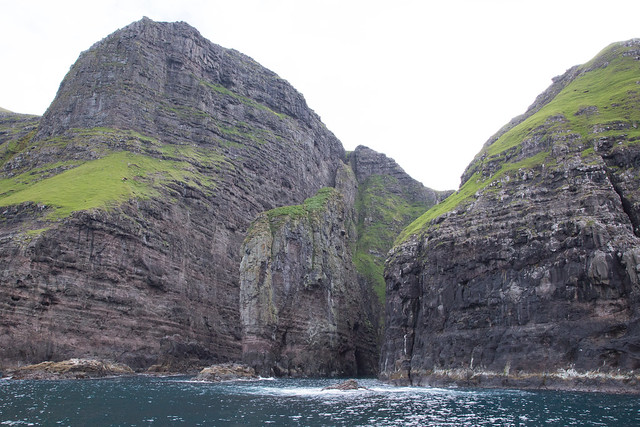
The cool thing about the Elephant is that he has puffins in his hair:

The grotto behind the Elephant is really deep:
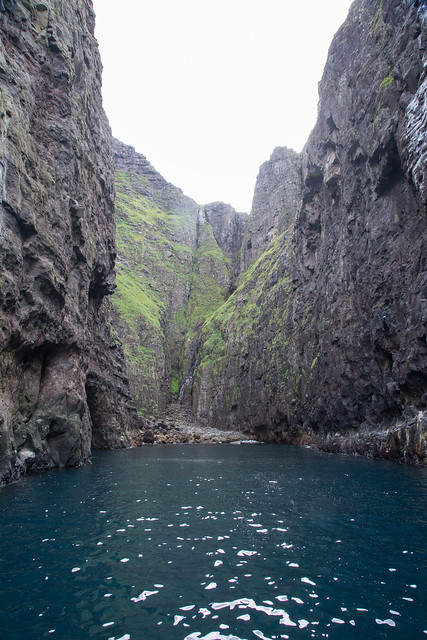
And you can pass through an arch in the Elephant (which we did):
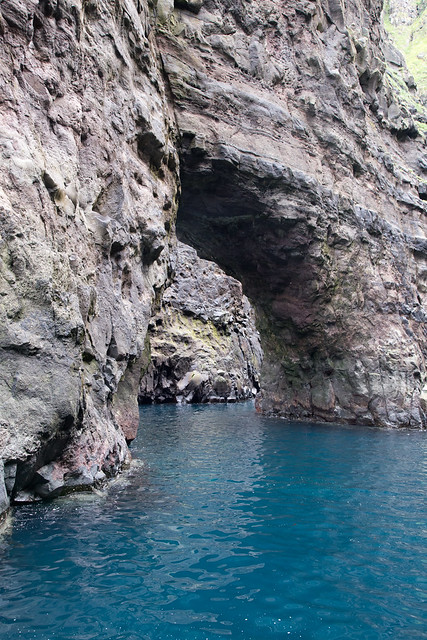
And emerge on the other side:
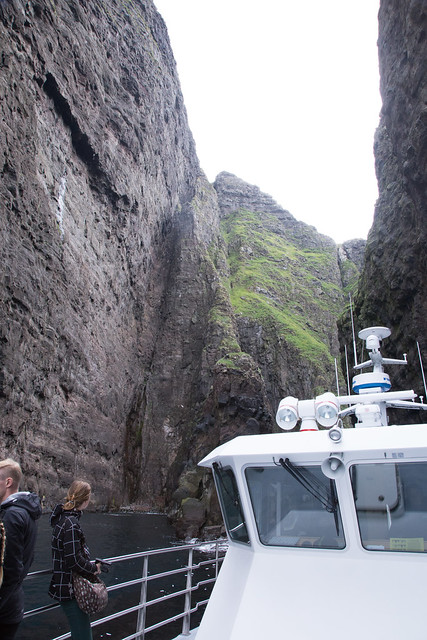
[1] Pretty sure that one is modern, since I don't think even Hannibal made it as far as the Faroes.

The cool thing about the Elephant is that he has puffins in his hair:

The grotto behind the Elephant is really deep:

And you can pass through an arch in the Elephant (which we did):

And emerge on the other side:

[1] Pretty sure that one is modern, since I don't think even Hannibal made it as far as the Faroes.
#24
Original Poster
Join Date: Mar 2008
Location: Grantham, NH
Posts: 530
Otherwise, it was mostly a lot of threading in and through some of the sea stacks:
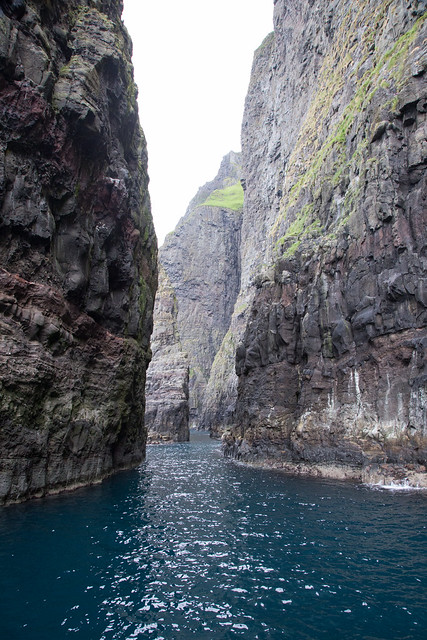
And looking up at tall (~750') cliffs:

And more narrow passages:
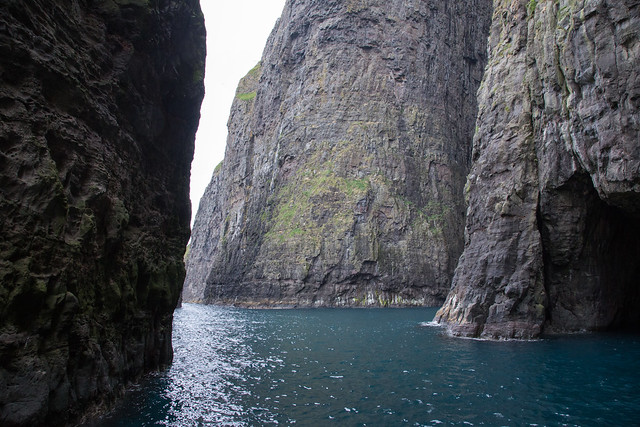
And some nice sea-stacks:

Which I deliberately undexposed, since in most of these photos the sky is washed out, obscuring the fact that the sky is full of birds, and almost deafening from their calls:
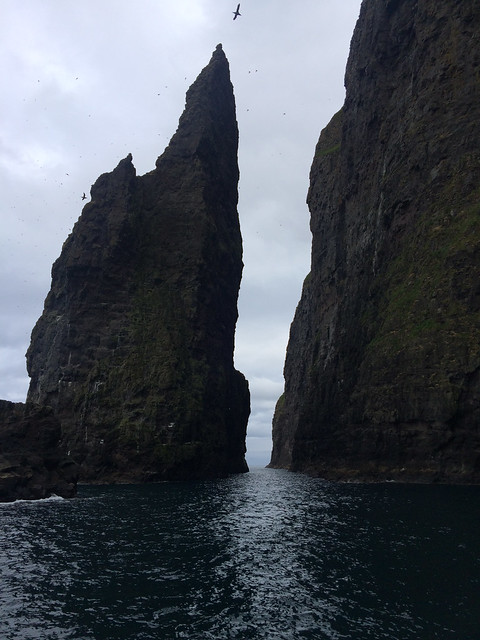

And looking up at tall (~750') cliffs:

And more narrow passages:

And some nice sea-stacks:

Which I deliberately undexposed, since in most of these photos the sky is washed out, obscuring the fact that the sky is full of birds, and almost deafening from their calls:

#25
Original Poster
Join Date: Mar 2008
Location: Grantham, NH
Posts: 530
See that ominous-looking cave... No, we didn't go into it...

We went around back...
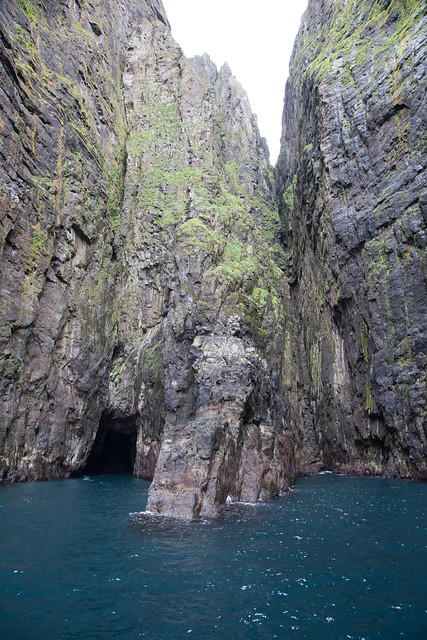
And came out of it:
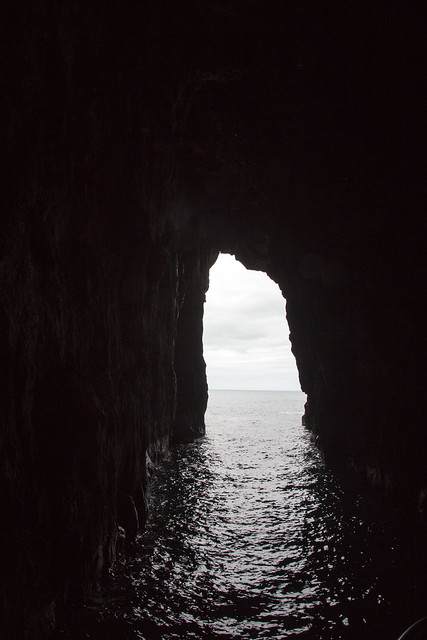
And soon enough, were back in Vestmanna:
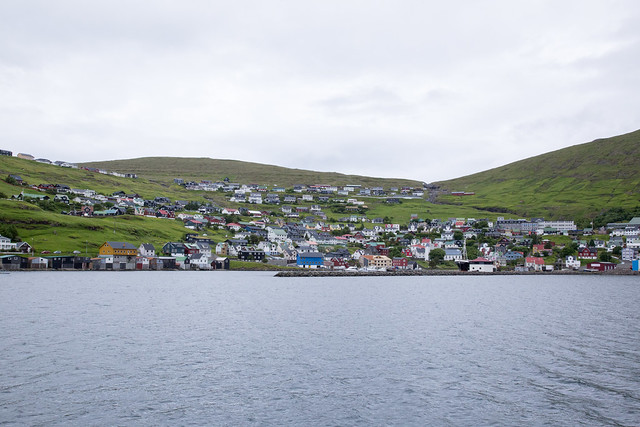
And then we were starving for lunch. Well, I had mentioned that, once you got outside of Torshavn, restaurants got pretty thin? Yeah, on the day we went there, Vestmanna had exactly one restaurant that was open (two more apparently had dinner hours only).
And every table was reserved by one of the tour buses.
So we went to the local grocery store and foraged, coming up with typical Faroese/Danish lunch fixings: various salami-style sausages, bread, cheese, and curry-flavored potato salad (they rather like curry mayo).
And Sisu, the soft drink of the Faroes!
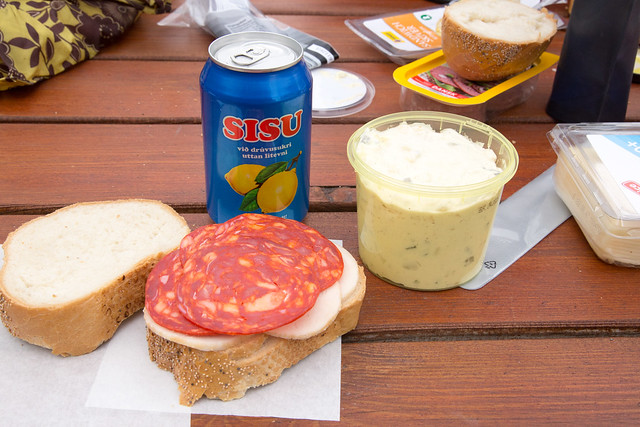

We went around back...

And came out of it:

And soon enough, were back in Vestmanna:

And then we were starving for lunch. Well, I had mentioned that, once you got outside of Torshavn, restaurants got pretty thin? Yeah, on the day we went there, Vestmanna had exactly one restaurant that was open (two more apparently had dinner hours only).
And every table was reserved by one of the tour buses.
So we went to the local grocery store and foraged, coming up with typical Faroese/Danish lunch fixings: various salami-style sausages, bread, cheese, and curry-flavored potato salad (they rather like curry mayo).
And Sisu, the soft drink of the Faroes!

#26
Original Poster
Join Date: Mar 2008
Location: Grantham, NH
Posts: 530
Leaving Vestmanna, the weather cleared up a bit, giving me a good chance to get a nice shot of the entire town, including the harbor (large, since it used to be a car ferry terminal) and one of the three hydroelectric dams:

At the top of the rise, we could see over to Esturoy (the next island up, and second largest island), which was a good demonstration of the steep mountains making their own weather as the wind drives moist air up into the colder upper atmosphere:

On our way back to Torshavn, we did a small diversion into the small town of Kvivik (this is probably a good place to mention that the limited number of towns, and even more limited roads between them, make it excessively difficult to get lost driving in the Faroes, since there are very few options to not take a direct route). Kvivik is one of the few towns to have a natural harbor, indeed, Kvivik is one of the oldest settlements, going back to Viking days.
But these days its mostly a quiet town:
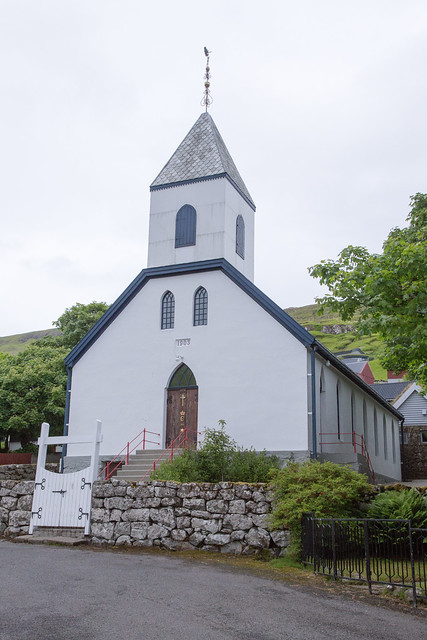
It does have a nice cemetery:
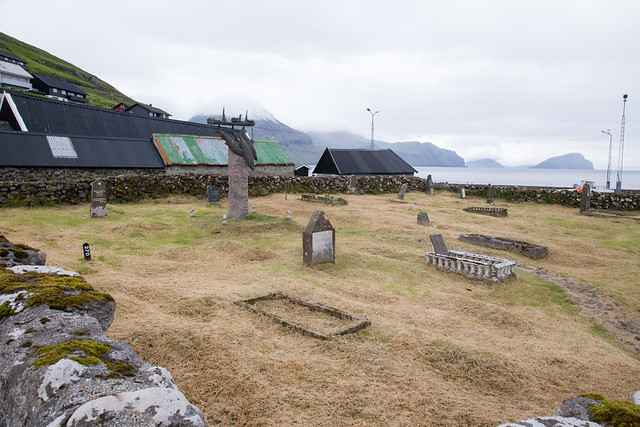
At the center of the cemetery is a nice memorial to the Stella Argus, a fishing vessel that sank with all hands in 1957, eight of them sailors from Kvivik:


At the top of the rise, we could see over to Esturoy (the next island up, and second largest island), which was a good demonstration of the steep mountains making their own weather as the wind drives moist air up into the colder upper atmosphere:

On our way back to Torshavn, we did a small diversion into the small town of Kvivik (this is probably a good place to mention that the limited number of towns, and even more limited roads between them, make it excessively difficult to get lost driving in the Faroes, since there are very few options to not take a direct route). Kvivik is one of the few towns to have a natural harbor, indeed, Kvivik is one of the oldest settlements, going back to Viking days.
But these days its mostly a quiet town:

It does have a nice cemetery:

At the center of the cemetery is a nice memorial to the Stella Argus, a fishing vessel that sank with all hands in 1957, eight of them sailors from Kvivik:

#27
Original Poster
Join Date: Mar 2008
Location: Grantham, NH
Posts: 530
Kvivik is one of the few natural decent harbors, so since Viking days it has been a harbor town. Indeed, when improving the harbor in the 1920s, they found evidence of Viking Longhouses and Storehouses, and have left the site mostly intact:
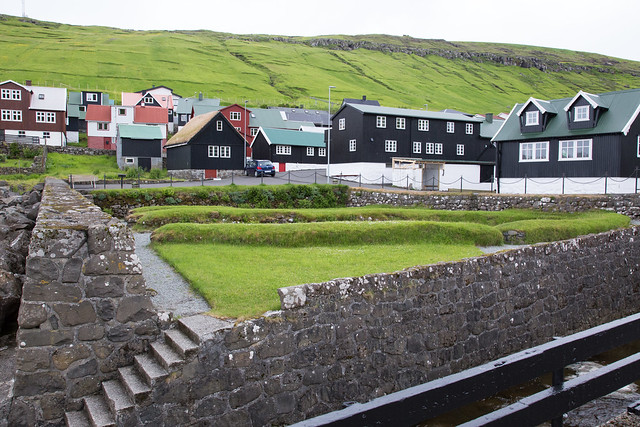
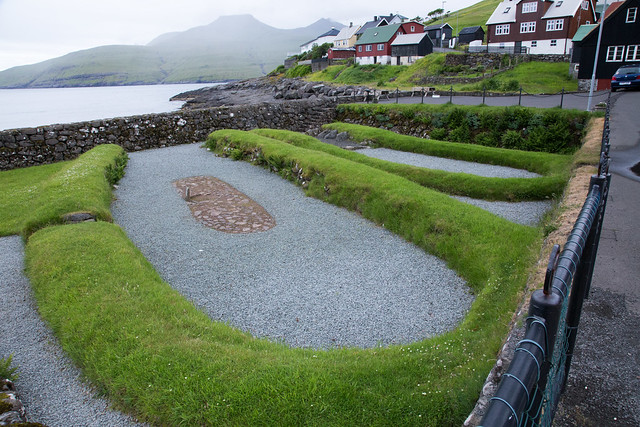
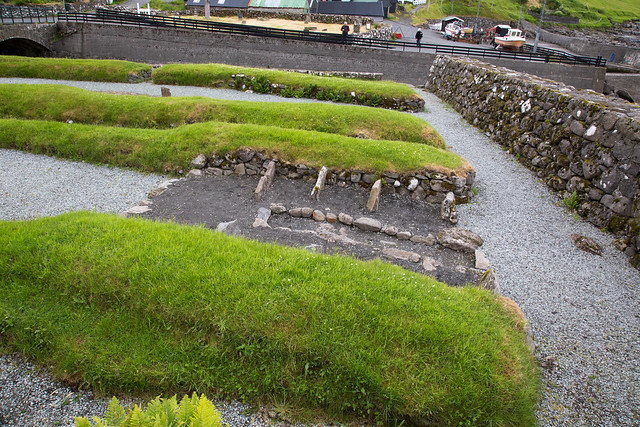
I realized I haven't given much in the way of example Faroese aside from a few placenames, so here's a nice sign:
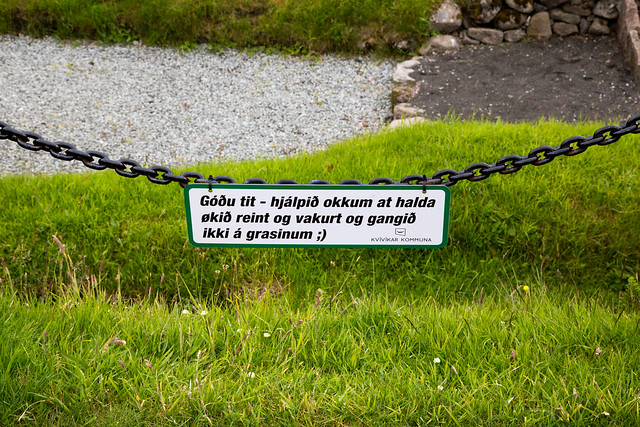
Google Translate doesn't work with Faroese, although you can sometimes get partial translations with Icelandic, since the languages are similar. For example, I recognize that "Gˇu tit" is basically "Welcome [you]", "Hjßlpi okkum" is "Help us", and "grasinum" is "grass (plural)".



I realized I haven't given much in the way of example Faroese aside from a few placenames, so here's a nice sign:

Google Translate doesn't work with Faroese, although you can sometimes get partial translations with Icelandic, since the languages are similar. For example, I recognize that "Gˇu tit" is basically "Welcome [you]", "Hjßlpi okkum" is "Help us", and "grasinum" is "grass (plural)".
#28
Original Poster
Join Date: Mar 2008
Location: Grantham, NH
Posts: 530
The next stop was Kollafj°rur. For years, this was a very quiet little town on one of Streymoy's more obscure fjords, but then opening of the Kollfjarartunnilin tunnel in 1992 substantially shortened the drive from Torshavn over to Vagar, and all of a sudden Kollafj°rur found itself just off the main road, and it's now a small suburb of Torshavn.
The church is interesting, since it's one of the best-maintained traditional churches. This is probably a place to mention that when you see black-colored Faroese houses, they aren't usually painted, but tarred:

Inside, it's a marvel of well-maintained unfinished wood and, apparently to survive winter weather, some pretty severe cross-bracing giving it a weird, low-clearance interior (I suspect people were shorter back then...):
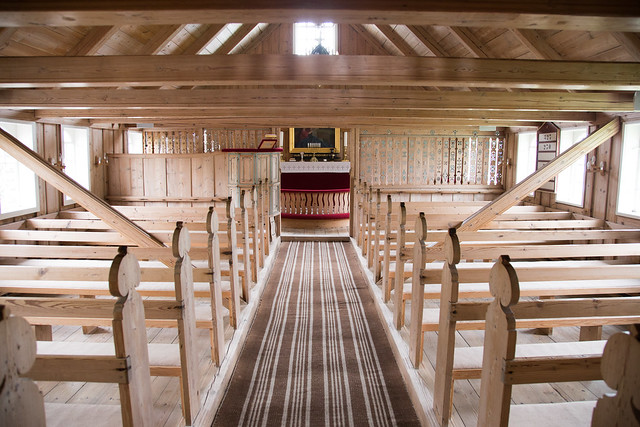
The detail on some of the woodwork is amazing:
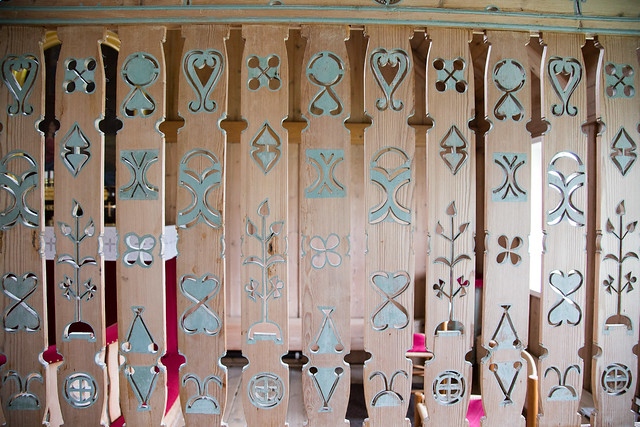
And hey, some more votive ships:
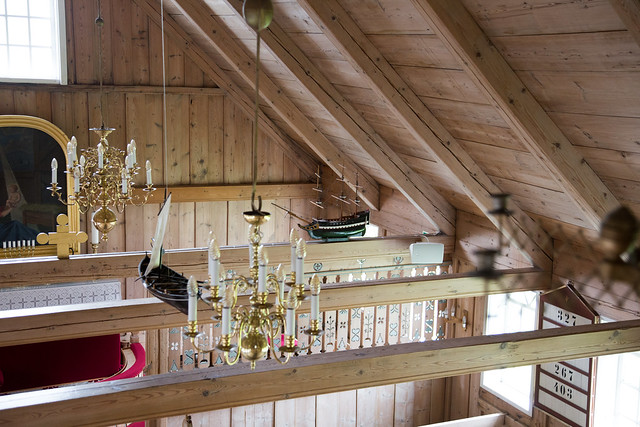
And, indulging my love of church organs, this church had a neat Danish-made compact organ that nicely wedges in under the rafters:
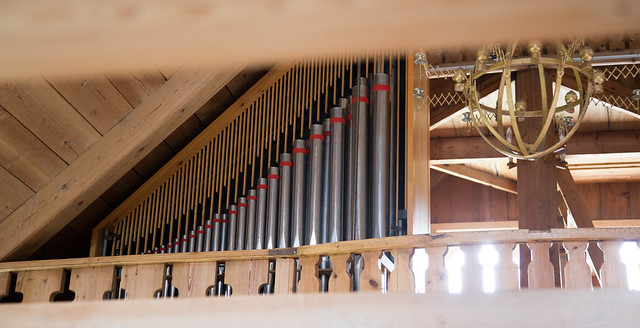
(Yes, I've always considered making a coffee table book about church organ. I may have to consider one on Votive Ships as well)
The church is interesting, since it's one of the best-maintained traditional churches. This is probably a place to mention that when you see black-colored Faroese houses, they aren't usually painted, but tarred:

Inside, it's a marvel of well-maintained unfinished wood and, apparently to survive winter weather, some pretty severe cross-bracing giving it a weird, low-clearance interior (I suspect people were shorter back then...):

The detail on some of the woodwork is amazing:

And hey, some more votive ships:

And, indulging my love of church organs, this church had a neat Danish-made compact organ that nicely wedges in under the rafters:

(Yes, I've always considered making a coffee table book about church organ. I may have to consider one on Votive Ships as well)
#29
Original Poster
Join Date: Mar 2008
Location: Grantham, NH
Posts: 530
A substantial fraction of Faroese homes, old or new, have a Hjallur. It's basically a partially vented (see the holes and vertical slats) drying room that's designed to allow moderately cool outdoor storage.
One of the primary uses is to make Skerpikj°t, the local delicacy: a leg of mutton is basically hung up and let ferment and dry for a period of time that's usually 9 months or more.
The result is a hard and dry mutton that's got a, well, particular taste and smell. (Yes, I tried it. I'll get to that later):

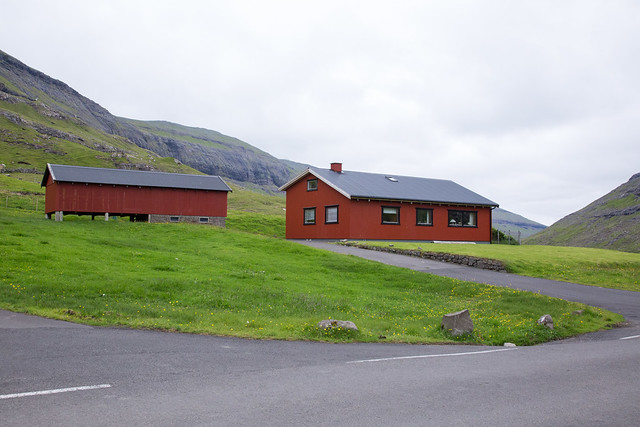
The next stop was Saksun. Back when Saksun was first settled, this was a town with a decent deep-water harbor, but a particularly brutal winter storm in 1600 resulted in the harbor getting blocked by sand, and made the town accessible only at high tide, or via a fairly long journey along the Dala river.
While accessible by road now, it's one of the shrinking villages of the Faroes, since every once in a while a family moves into one of the larger communities.
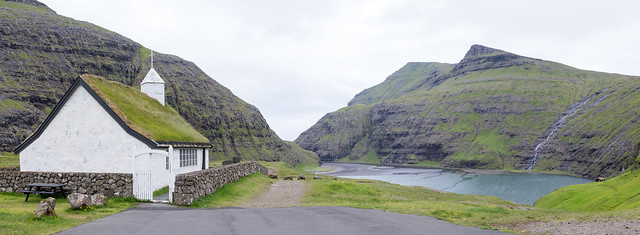

And Saksun had a lot of these nesting around. This is an Oystercatcher, the national bird of the Faroes. They are pretty fiercely territorial, so it's not uncommon for you to get too close to one and have it very loudy circle and swoop at you.

One of the primary uses is to make Skerpikj°t, the local delicacy: a leg of mutton is basically hung up and let ferment and dry for a period of time that's usually 9 months or more.
The result is a hard and dry mutton that's got a, well, particular taste and smell. (Yes, I tried it. I'll get to that later):


The next stop was Saksun. Back when Saksun was first settled, this was a town with a decent deep-water harbor, but a particularly brutal winter storm in 1600 resulted in the harbor getting blocked by sand, and made the town accessible only at high tide, or via a fairly long journey along the Dala river.
While accessible by road now, it's one of the shrinking villages of the Faroes, since every once in a while a family moves into one of the larger communities.


And Saksun had a lot of these nesting around. This is an Oystercatcher, the national bird of the Faroes. They are pretty fiercely territorial, so it's not uncommon for you to get too close to one and have it very loudy circle and swoop at you.

#30
Original Poster
Join Date: Mar 2008
Location: Grantham, NH
Posts: 530





















